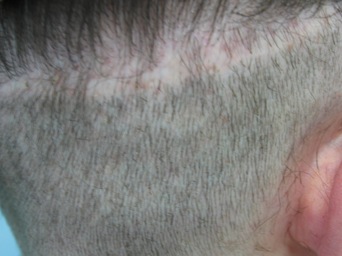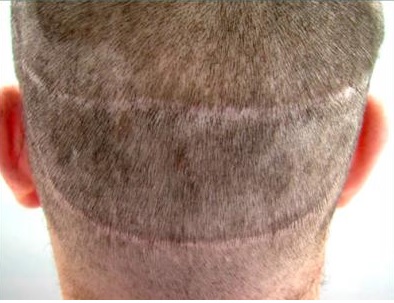- a) a surgical procedure that results in no scarring to the donor area
- b) a hair transplantation technique wherein the surgeon donates a strip of his own hair
- c) a surgical hair transplantation technique in which the surgeon extracts a strip of flesh from the donor area
- d) a) and c)
- e) none of the above
2) Strip surgery is often also referred to as:
- a) follicular unit strip surgery – FUSS
- b) Follicular Unit Transplant – FUT
- c) the “traditional” method
- d) all of the above
- e) a) and b)
3) In strip surgery, the donor area is:
- a) the vertex of the scalp
- b) always the hairline
- c) the mid-back portion of the scalp
- d) the legs
- e) the nape of the neck or behind the ears
4) After extraction, the strip of flesh is then cut up into:
- a) quarters
- b) follicular units
- c) eighths
- d) small enough grafts for implantation into the recipient area
- e) none of the above
5) The harvested strip leaves a linear wound to be closed with:
- a) stitches
- b) staples
- c) surgical tape
- d) any of the above may be used
- e) the wound heals naturally and no closure is required
6) Strip surgery requires the surgeon to have a lower level of skill than an FUE surgeon.
- a) true
- b) false
7) The image below shows:

- a) a harvested donor strip
- b) a centipede
- c) several follicular units in a strip of flesh
- d) a) and c)
- e) none of the above
8. In strip surgery, follicular units are implanted:
- a) one by one
- b) into the balding recipient area
- c) after being divided up from the initial donor strip
- d) all of the above
- e) none of the above
9. Strip surgery is best known for leaving:
- a) a different colored patch of hair
- b) a linear scar (and possibly more than one)
- c) weird bumps on the scalp
- d) a slot formation scar
- e) scarring on the posterior hairline
10. One problem with having a strip scar is that it:
- a) will most likely limit the hairstyle of the recipient in order to conceal it
- b) is an obvious sign of hair transplantation
- c) may be difficult to cover up in certain scenarios, i.e. windy weather or while swimming
- d) all of the above
- e) none of the above
11. One would be considered a poor candidate for strip surgery if:
- a) he only wants hair transplanted to the crown
- b) he is of Asian decent
- c) he has severe baldness
- d) he does not exercise regularly
- e) needles make him queasy
12. Strip surgery is not the best choice for hairline restoration because:
- a) new hair along the hairline will fall out
- b) donor hair is limited to the mid-back portion of the head, where hair is thickest
- c) thicker donor hair will result in an unnatural, harsh-looking hairline
- d) it will cause the hair along the hairline to grow in a different direction
- e) b) and c)
13. The scar resulting from strip surgery may begin as “paper thin,” but can stretch and worsen over time.
- a) true
- b) false
14. The image below shows:

- a) a half-shaved head
- b) the typical donor area for strip surgery
- c) a strip scar
- d) a) and c)
- e) all of the above
Answers: 1: c, 2: d, 3: c, 4: b, 5: d, 6: a—true, 7: d, 8: d, 9: b, 10: d, 11: c, 12: e, 13: a—true, 14: e

